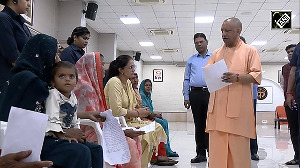Your cell phone has the attention of the Indian banking and financial services community. That is not surprising since 300 million people own mobiles today. And in four years, 700 million will! All bank customers will boast of one.
However, not all mobile owners will have a bank account -- or even want one! What they will want are financial services beyond the traditional banking offering, eg a savings account. The mobile provides the best ever delivery channel for such inclusive banking. If 'No Indian Left Behind' is to be the vision statement for financial sector reforms, mobile provides the best way to achieve it in the next decade.
Banks were savvy about using mobile for extending banking alert/ information/ query-based activities for some time. A few pushed ahead using the mobile (linked to their account) for financial transactions viz bills, premia, tickets, gifts, top up, shopping, etc with the active partnership of specialised homegrown technology providers. Most banks who ventured into mobile banking have realised that while plain vanilla mobile banking is another cost-effective delivery channel for basic banking services, the real benefits -- convenience and revenue stream -- come from enabling mobile payments for their customer base.
One can argue that you and I have been doing mobile commerce all along without knowing it! Pre-paid mobile re-charge for card holders is quite pervasive. Today, the bank customer can re-charge his mobile using any secure channel -- ATM, internet or mobile. The value of this market is about Rs 4,000 crore (Rs 40 billion). It is not only a business proposition with its own revenue profile but also a tipping point for the penetration of mobile banking services. The real-time, pain-killer, distance-independence and anytime-anywhere features persuade the sceptic to try out the service because it solves a problem -- instant top-up remotely without having to go across the counter.
The Reserve Bank of India has come out with its final guidelines on this category of financial services after several iterations (presumably trying not to stifle the take-off of m-banking services). However, the RBI is not a technology regulator; with the fast pace of innovations in this sector, it will never be able to drive forward by looking at the rear-view mirror. To be effective, the regulatory framework for m-banking will have to continuously accommodate its special features.
The following are some key factors will that determine successful adoption of m-banking in the country for banked and unbanked customers, business correspondents, independent technology providers, businesses, regulators, etc:
In many countries, eg Kenya, Tanzania, Philippines, South Africa, Japan and South Korea, the cell phone has become an instrument of payment/transfer of money. A cell phone can today facilitate welfare transfers such as NREGS, disbursements/ remittances, micro-credit, insurance, repayment/ collection, all in real time through simple, easy-to-use instructions and in a cost-effective way. The recent report of the Committee on Financial Sector Reforms, chaired by Prof Raghuram Rajan, states that using technology "transactions as small Rs 100 can be done at a reasonable transaction cost..." The mobile serves as an effective medium for electronic transfers and the accompanying transaction authorisation system.
In summary, banking today is a consumer financial service. It has to have elegance and simplicity woven around its user interfaces and touch points for it to become less daunting to the illiterate, uninitiated and veteran alike. Without this, the goal of boosting integration into the formal financial system, rather than continued dependence on the unaccounted informal financial system, will remain elusive.
The next challenge is for the RBI to set broad guidelines for addressing financial inclusion via use of the mobile phone. Within a few months of usage experience under its belt, the RBI will have useful customer data to refine its thinking further to continue to give a fillip to the industry, while safeguarding customer interests and mitigating systemic risks.
The writer is co-founder, PayMate.





